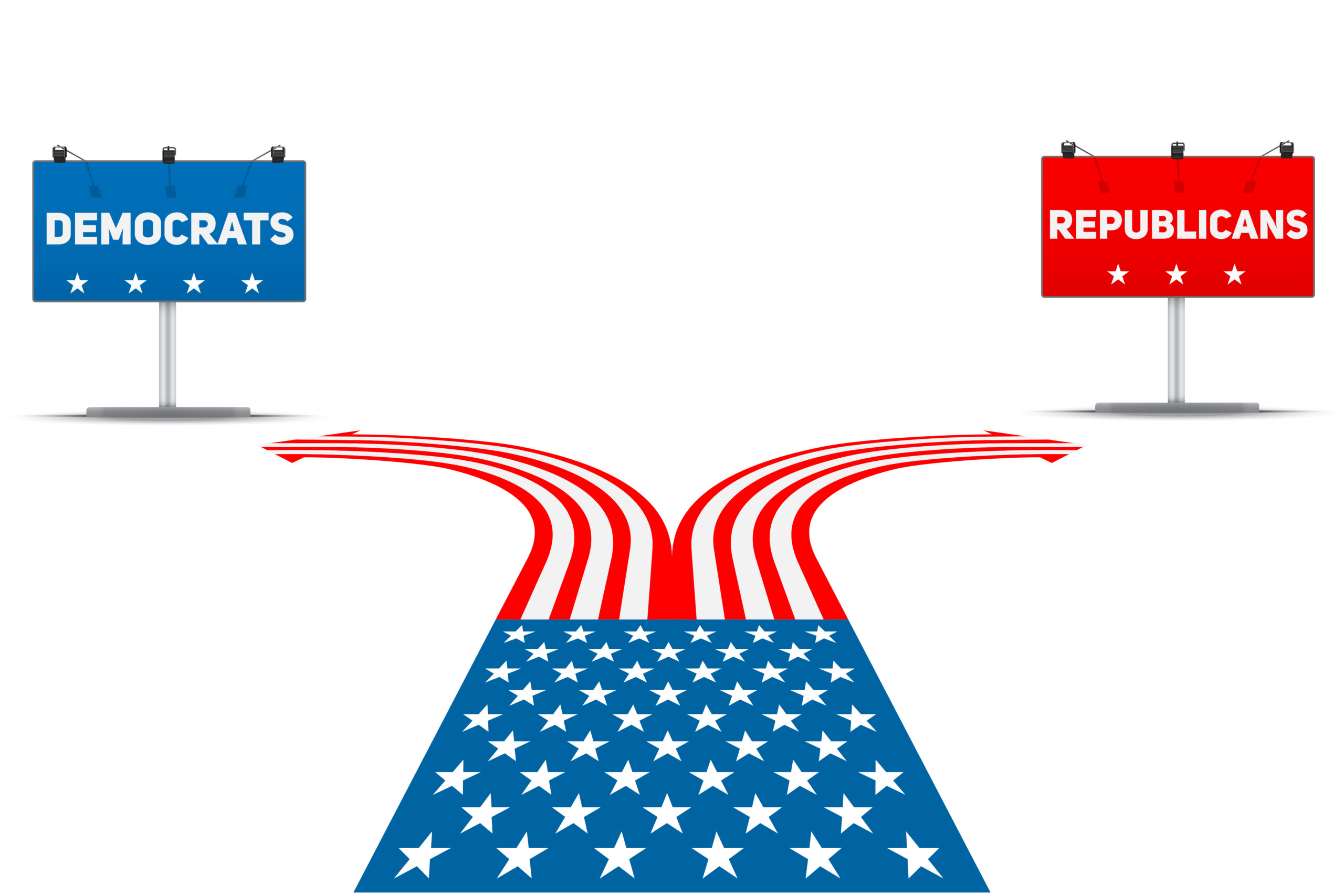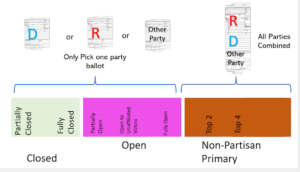By AM Benjamin
Primaries are a means by which voters select their preference for candidates of specific parties to advance to a general election. For the most part, the political primary is a unique feature of American democracy. Given increased political polarization, it’s worth exploring whether primary reform can remedy some of what ails us by reducing that political polarization. This article is designed to provide some background on political primaries, how it relates to Ranked Choice Voting, and its role in electoral reform.
First, it is essential to understand where primaries occur. In the United States, we have primaries at virtually every level of elections:
- Presidential
- Congressional
- Statewide office (I.e. Governor, Secretary of State)
- State legislatures
- Local elections
How Primaries Differ from a General Election
The main difference between primaries and general elections is that in a general election, any U.S. citizen over the age of 18 is eligible to vote provided they satisfy the requisite residency requirements in their state. In primaries, however, participation is a bit more complicated.
The rules about who can participate in a political primary are governed by laws and regulations from the state governments and the parties with some constraints based on the federal law and the constitution/ courts. In primaries, states have broad authority to determine the structure, process, ballot access, and voter eligibility. But in many cases, states do leave authority for making some or of all of these decisions to the parties. This is in contrast to the general election which is completely under the purview of the state. To participate in a party’s primary, voters are often required to identify with that specific party in some form. This type of eligibility decision revolves around these categories:
- Voters who are registered or aligned with a political party (Democrat, Republican, Libertarian, Green)
- Voters who are not affiliated with any party, or unaffiliated voters. These independent voters represent an important demographic because more and more Americans are choosing not to align or identify with any party.
The rules that govern how voters can participate in political primaries focus on two important aspects:
- Are unaffiliated voters allowed to participate in a political party’s primary?
- Is crossover voting allowed (in other words can a Democrat vote in a Republican party primary or vice versa)?
Types of Primaries
Generally speaking there are three types of political primaries: Closed, Open, and Nonpartisan.
In closed primaries, voters must be affiliated with the party primary that they intend to vote in. For this, they need to register with that party or change their vote registration beforehand. This is important as there are many voters who prefer not to formally identify with a political party and in many cases may be shut out of the voting process.
In closed / open primaries, each political party has their own ballot. Voters can only submit the ballot for that particular party. For example in Colorado, which is classified as an “Open Primary” state, all eligible voters are mailed both the Democratic Party and Republican Party ballots. A voter is only eligible to submit one party’s ballot.
In nonpartisan primaries, all the parties are combined on to one ballot and voters choose from a list of candidates across the political spectrum to decide who advances to the general election.
Some primaries have rules where candidates must meet a threshold to win a majority of the vote (over 50%). If not, the two candidates advance to a runoff.
For further reading, I will direct any interested reader to the primary types definitions from the National Conference of State Legislatures.
Exceptions explained
- States can have different types of primary rules depending on the types of elections. For example, while Arizona allows open primaries at the state and congressional level, their Presidential primaries are closed. Similarly, while California has a closed primary for selecting president, their congressional and state elections are top 2 (nonpartisan).
- Even if a state is classified as a “closed” primary state, it is ultimately up to the party to decide who votes. For instance, Oklahoma and Utah are classified as “Closed Primary states,” but the Democratic parties in those states have amended the rules to allow independent voters to participate.
- In other instances a state can have a closed primary but it is primarily referring to the two major parties within the state. For instance, New York has closed primaries for both the Democratic and Republican parties. Yet the Reform Party is open to unaffiliated voters.
- Finally, just because a state has open primaries does not mean that crossover voting is always allowed. For instance, Alabama is an open primary state with a majority win requirement (a candidate must be above 50% to win the primary). Yet voters cannot vote in one political party’s primary and then vote in another political party’s runoff within the same election cycle.
How Political Primary Reform is Related to Ranked Choice Voting (RCV)
There are three important ideas within the primary reform movement:
Open Primaries: The first is a push towards encouraging more parties in states to move to open primaries. The argument is that with more and more voters choosing not to identify with a political party, primaries should allow these unaffiliated voters to engage in the democratic process. And in many cases, due to political polarization, and complications with redistricting, most general elections are uncompetitive. This means in many cases, primary elections are the only ones that matter.
Nonpartisan Primaries: The other is a push towards Nonpartisan Primaries, which would do away with the political parties controlling primaries and have all candidates appear on one ballot. That way all voters could choose who would advance to the general election. In many cases, the primary reform movement is trending in this direction and this change may be easier to accomplish in states with initiatives, referendums, and propositions. To date, only four states have experimented with some form of nonpartisan primaries (California, Washington, Louisiana and Alaska)
Eliminate Primaries altogether: Finally ,one controversial school of thought is to eliminate primaries altogether. There are many reasons for this popular view in academia although it has not been fully embraced by the general public. While this may sound strange, most countries in the world do not have public primary elections.
So the overall question becomes how are primary reform and Ranked Choice Voting related? An exchange by Elon Musk and Andrew Yang showcases that many people are prone to lump these two reforms together:
Is this a reference to open primaries? I think those are a good idea.
I am in favor of anything that would result in more centrist candidates being elected!
— Elon Musk (@elonmusk) June 1, 2022
While open primaries and ranked choice voting are distinct ideas, reformers are using both to expand electoral participation. This is seen with the creation of the Alaska Top-4 primary. Under this system, all eligible candidates (regardless of party affiliation) are on one ballot for the primary. The top four candidates (regardless of party affiliation) advance to the general election and voters choose the candidate based on Ranked Choice Voting. Given the uniqueness of this novel primary and voting reform, Alaska’s upcoming Congressional and Senate elections are receiving a lot of attention across the country. An alternative version of this pioneered by Katherine Gehl at the Institute of Political Innovation known as Final Five Voting has the same principles as Top 4 but would allow five candidates to advance to the general election.
Advocates are banking on this movement to solve some of our political problems as it offers voters more options in the general election. The added RCV element ensures that the candidate that wins must command a majority of the votes. Still others are more skeptical of its intended benefits and have raised doubts over whether such changes could really change the trajectory of political discourse.
While I think it will take a couple more election cycles in more states to fully understand the impact, primary election reform and ranked choice voting represent a promising combination of complementary electoral innovations that could improve the dynamics of American politics.
The views and opinions expressed in this article are those of the authors and do not necessarily reflect the official policy or position of Rank the Vote, its members, supporters, funders, or affiliates.


